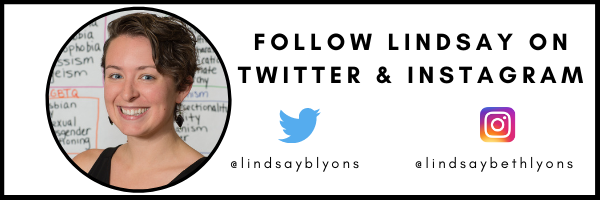TL;DR:
- Becoming an edupreneur was challenging at first, but there are ways to support the transition.
- Stick with your values when it comes to sharing your work, getting paid, and supporting teachers.
- Promote your work. You want others to see what you have to share.
- Find systems and tools to keep you organized.
Switching from a classroom teacher to running my own coaching business has been a major shift. As a teacher at heart, I feel most comfortable creating instructional content and coaching. In my edupreneur role, I struggle to market my work (e.g., talk about my paid services and balance time spent sharing my work with time spent creating and coaching). It’s also challenging to navigate the uncomfortable feeling of asking teachers for money when we all know teachers are incredibly underpaid.
Here’s how I’m grappling with this stuff:
Business Decisions: Stay Grounded in My Values
Rick Mulready has shared the importance of identifying your business values and using them to make business decisions. The most important value for my business is justice.
Using a justice-based lens, I have decided to primarily focus on working with school and district-level leaders so I can have a larger impact (reaching more students and transforming systems). Furthermore, I will be paid through PD budgets, not from teacher paychecks. For individual teachers who want support but whose school is unable to work with me, I offer a self-paced course version of my coaching for teachers (increasing access). I also work with administrators to see if the school can pay for it. Additionally, I provide 90% of the content in my course for free via my podcast, blog, and weekly free resources. The course, then, is a way to save time because all of the relevant information is distilled down to the most relevant and housed in a centralized place with creation-based activities along the way.
This feels much more aligned with how I want to show up and serve educators and their educational communities.
When speaking with school leaders or submitting proposals to districts, I remind myself that what I offer is valuable. Click To TweetNaming the Price: Consider the Value of the Transformation
When speaking with school leaders or submitting proposals to districts, I remind myself that what I offer is valuable. A chance to engage all students as change makers, build leadership capacity, and affirm students’ identities. Who wouldn’t want that? I’ve heard business coaches talk about asking, “What would this outcome be worth to you?” (Another important value of my business is transparency. I will always state the price of my services and products upfront. However, this framing is compelling to me.) Imagine: 100% of students in a school saw their schools as places that affirmed all aspects of their identities, and they saw themselves as effective leaders capable of transforming communities. That’s worth like $1,000,000!
Promoting My Work: Show Up and Serve
I used to think promoting my work had to be telling people about the paid services I offer. Then, I got a lot of great advice from people like Jeff Gargas. And I realized helping people is the most effective and values-aligned way I can promote my work. (Bonus Tip: Teach Better’s Edupreneur Mastermind is definitely worth checking out. I’ve learned a lot of gems like this in there.) Now, I focus my marketing efforts on sharing the free content I create (i.e., blog posts, podcast episodes, YouTube videos, free templates, and resources) on my social media channels and by hopping on other educational leaders’ podcasts.
Promoting My Work: A System to Stay Focused
Creating and sharing thoughtful content regularly can get a bit unwieldy without a system to help me stay focused. Each month, I typically create 4 podcast episodes, 4 blog posts (these are summaries of the podcast episodes), 4 YouTube videos, 4 email newsletters, and 20 social media posts (on Twitter and LinkedIn only). Each week, I block about 2-4 hours of my schedule to batch-complete the following month’s content. So, on the first Monday of the month, I’ll plan and record YouTube videos. On the second Monday, I’ll type blog post summaries. For the third Monday, I’ll write and schedule email newsletters and social media posts. And on the last Monday of each month, I’ll plan and record podcast episodes.
At this point in my business, I pay two fantastic contractors to help with the logistical pieces (creating promotional graphics in Canva, scheduling blog posts on my website and the Teach Better Podcast Network’s site, and editing and scheduling podcast episodes and YouTube videos) for a total of about 20 hours of work each month. I try to stay one to two months ahead of my content creation so they have time to put everything together and schedule all of the month’s content to be published by the first of the month.
[scroll down to keep reading]
Promoting My Work: Use Tech Tools to Save Time and Stay Organized
Two tech tools that have proven to be major time-savers in this work are Calendly (for scheduling podcast guests and sending them the questions and guest information Google Form, prospective client calls, and coaching calls) and Later (for scheduling social media posts). For organizing all of my content ideas, I typically use a Google Sheet for the podcast episodes (e.g., air date, guest information, freebie link, title) and another one for the YouTube videos. Finally, I use lots of templates for things like blog posts, captions, alt text, Canva graphics, and email newsletters.)
I do not have this all figured out. I’m learning as I go, but I’m happy to be doing it alongside a community of entrepreneurs in the Teach Better Community. Want to join us? Check out the Edupreneur Mastermind at this link. I’m happy to share more about my experience in the group with you, so please reach out to connect!
About Lindsay Lyons
Lindsay Lyons is an educational consultant who works with teachers and school leaders to inspire educational innovation for racial and gender justice, design curricula grounded in student voice, and build capacity for shared leadership. Lindsay taught in NYC public schools, holds a PhD in Leadership and Change, and is the founder of the educational blog and podcast, Time for Teachership.





